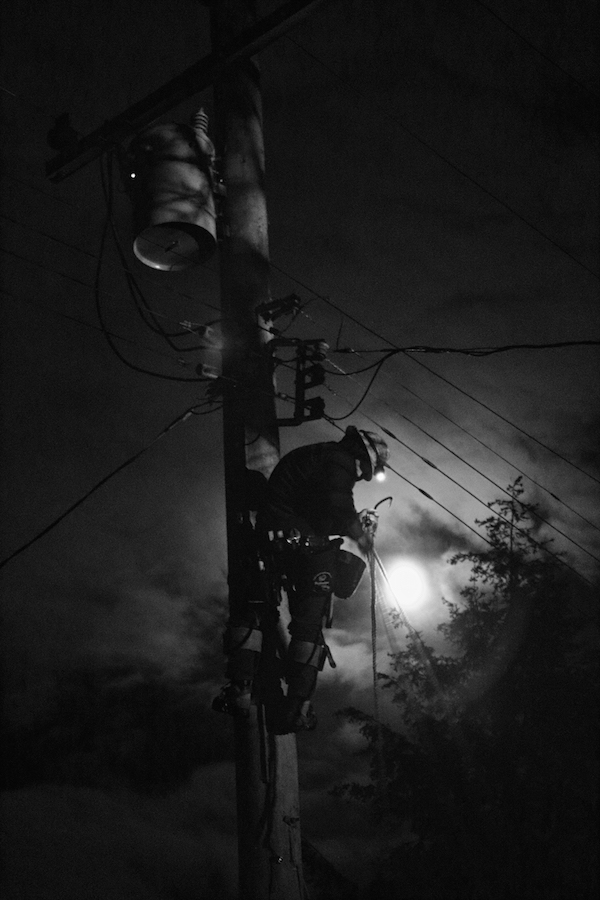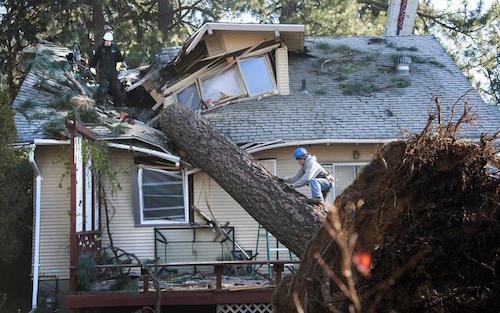On Tuesday, Nov. 17, a powerful windstorm ripped through the Pacific Northwest, northern Rockies and the northern High Plains, leaving a wake of destruction, misery and bitter cold.

|
| Photographer Erv Schleufer captures an IBEW lineman working to repair storm damage in his back yard. He used infrared photo technology to capture the stunning image. See more of Schleufer’s infrared photos.
|
At the peak of the storm, record-setting wind gusts in parts of central and eastern Washington reached 119 mph, toppling trees, flipping semitrailers and ripping the roofs off of homes.
When the skies calmed, more than a million people were left without power, including Spokane, Wash., resident Erv Schleufer.
Overnight, a 100-foot ponderosa pine snapped in his neighbor’s yard, taking Schleufer’s electrical service line with it and ripping the meter off the side of his house. Left to work out how to reconnect his home to the grid, the retired UA and Steelworkers member knew one thing for certain: he was going to use union labor.
His call to Spokane’s Electric Smith, a signatory contractor, led Las Vegas Local 357 wireman Brian Bendele to his door, and the two struck up a quick friendship while getting Schleufer’s house reconnected.
But it would be eight more long, cold days before the line crews working in the area would be able to restore power to his hard-hit northwest Spokane neighborhood, and in the meantime, Bendele generously offered to loan his brand new gasoline-powered generator to this stranger-turned-friend.
“Our power came back on, and people in a community have to look after one another when times are tough,” Bendele said. “His trees had taken out the high lines to the whole neighborhood, so I knew it was going to be a while before they got their power back.”
“It’s that kind of thing that really restores your faith in humanity,” Schleufer said of Bendele’s generosity. “He had no reason to do something so kind for us, but he did, and it made a world of difference during that week. We had a place to charge our phones and we could run the heaters at night to keep the pipes from freezing.”
Heroes in the Aftermath
Days later, when the lights finally did come back on, Schleufer noticed a ground line arcing in his back yard. “I ran down the street to where there was a line crew working and they came right away,” he said. While one of the linemen was up the pole fixing the problem, Schleufer grabbed his camera.
The result was a hauntingly beautiful silhouette captured in black and white using a special infrared technology Schleufer has been using for the last couple of years.
“I just thought that picture showed these linemen the way they ought to be portrayed,” he said, “as heroes.”
And for the 180,000 Spokane families without power enduring the freezing temperatures that accompanied the storm’s aftermath, the characterization was not uncommon.
“We sometimes forget that these devastating storms can happen anywhere, and I am proud of our represented linemen and crafts people who will leave their families in the dark to restore power,” said Seattle Local 77 Business Manager Louis Walter, whose local represents the nearly 200 IBEW linemen working for Spokane’s Avista Utilities.
The Spokane area typically has about 15 local line crews, but after the storm, the number swelled to nearly 160, including another 500 IBEW linemen from contractors or other utilities who assisted in the cleanup operation.
For almost all of the affected customers, the lights were back on by Thanksgiving, a remarkably quick recovery for a storm Avista described as its “largest crisis in 126 years.” In the Spokane area alone, 42 major transmission lines and 23 substations were out of commission.

|
| Damage from the November 2015 windstorm in Spokane. Photo courtesy of Local 77.
|
“The Northwest storm recovery is just another example of the outstanding service IBEW linemen put in all over the country, day in and day out,” said IBEW Utility Department Director Jim Hunter.
“We’ve got a Code of Excellence, and we’re committed to being the best and to doing our work safely and efficiently. That’s especially important during times of crisis,” he said. “People notice that we’re there helping them clean up and get their power back on, and they really appreciate our commitment to our jobs and to our communities.”
For Schleufer, his photo of an IBEW lineman, whose name he wasn’t able to catch, was emblematic of the region-wide effort. “He’s up there all in the dark just helping people get their lights on,” he said.
“It’s no different than the firefighters who battled the forest fires we had here over the summer,” he said. “When the community needs them, these hard-working union men and women come to the rescue. We owe them a lot of gratitude.”